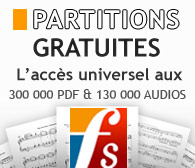| Saint-Saens, Camille - Fugue in G Major from 6 Fugues for Woodwind Quartet Op. 161 No. 3 Quatuor à vent: Flûte, Hautbois, Clarinette, Basson |
VoirPDF : Fugue in G Major from 6 Fugues (Op. 161 No. 3) for Woodwind Quartet (7 pages - 157.25 Ko)174x⬇ MP3 : Fugue in G Major from 6 Fugues (Op. 161 No. 3) for Woodwind Quartet 24x⬇ 333x
| Compositeur : | Saint-Saens, Camille (1835 - 1921) | ||||
| Instrumentation : | Quatuor à vent: Flûte, Hautbois, Clarinette, Basson | ||||
| Genre : | Romantique | ||||
| Tonalité : | Sol majeur | ||||
| Arrangeur : Editeur : | MAGATAGAN, MICHAEL (1960 - ) | ||||
| Date : | 1920 | ||||
| Droit d'auteur : | Public Domain | ||||
| Ajoutée par magataganm, 29 Jui 2019 Camille Saint-Saëns was something of an anomaly among French composers of the nineteenth century in that he wrote in virtually all genres, including opera, symphonies, concertos, songs, sacred and secular choral music, solo piano, and chamber music. He was generally not a pioneer, though he did help to revive some earlier and largely forgotten dance forms, like the bourée and gavotte. He was a conservative who wrote many popular scores scattered throughout the various genres: the Piano Concerto No. 2, Symphony No. 3 ("Organ"), the symphonic poem Danse macabre, the opera Samson et Dalila, and probably his most widely performed work, The Carnival of The Animals. While he remained a composer closely tied to tradition and traditional forms in his later years, he did develop a more arid style, less colorful and, in the end, less appealing. He was also a poet and playwright of some distinction. Saint-Saëns was born in Paris on October 9, 1835. He was one of the most precocious musicians ever, beginning piano lessons with his aunt at two-and-a-half and composing his first work at three. At age seven he studied composition with Pierre Maledin. When he was ten, he gave a concert that included Beethoven's Third Piano Concerto, Mozart's B flat Concerto, K. 460, along with works by Bach, Handel, and Hummel. In his academic studies, he displayed the same genius, learning languages and advanced mathematics with ease and celerity. He would also develop keen, lifelong interests in geology and astronomy. Saint-Saëns was a piano virtuoso and a composer of bravura brilliance. His Six Fugues, Op. 161 are masterly and complex character studies, devoid of academic leanings, whilst his famous Allegro appassionato, Op. 70 possesses brilliance and lyrical depth. The Thème varié, Op. 97 is witty and explosive, the Suite, Op. 90 full of charm, and the Allegro, Op. 29 possessed of dazzling breadth. Source: Allmusic (https://www.allmusic.com/composition/%C3tudes-6-for-pi ano-op-52-mc0002358821). Although originally composed for piano, I created this interpretation of the Fugue in G Major from 6 Fugues (Op. 161 No. 3) for Woodwind Quartet (Flute, Oboe, Bb Clarinet & Bassoon). Download the sheet music here: https://musescore.com/user/13216/scores/5658375 Partition centrale : | Six Fugues (6 partitions) | | |||








